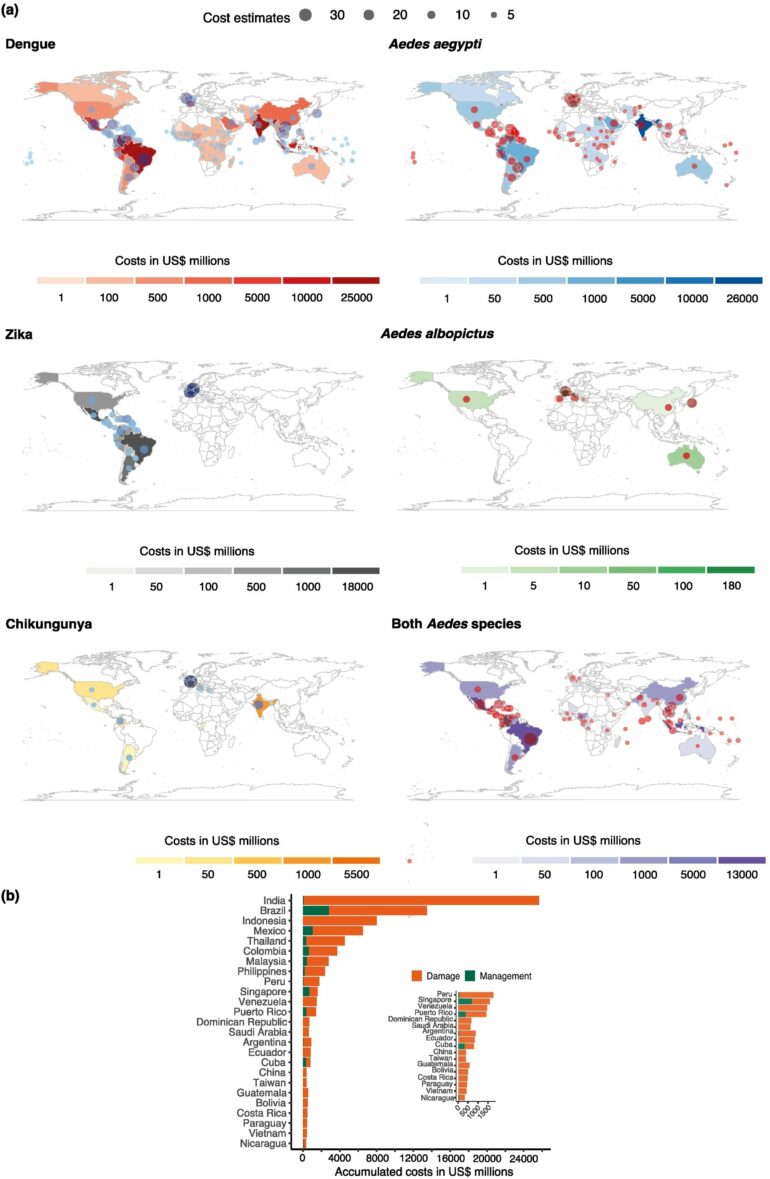An international study led by scientists from IRD, CNRS and MNHN reveals the massive increase in the global economic cost of the invasive Aedes aegypti and Aedes albopictus mosquitoes, vectors of dengue fever, chikugunya and the Zika virus, over the last few decades.
The study is published in the journal Science of The Total Environment.
Between 1975 and 2020, the estimated total costs amounted to some US$94.7 billion. While the costs associated with the losses and damage caused by these mosquitoes and the diseases they transmit are underestimated because they are seldom quantified or reported in many countries, they have literally exploded since the early 2000s.
At the same time, investment in the management and prevention of these diseases has remained stable, representing only a fraction of total costs. The expected benefits of implementing effective, sustainable prevention strategies are colossal.
Using a dataset and typology of specific costs associated with damage and loss—direct medical costs, direct non-medical costs and indirect costs—caused by dengue, chikungunya and Zika, this study is the most recent, comprehensive, standardized, robust and accurate compilation of costs associated with invasive Aedes species and Aedes-borne diseases, reported worldwide between 1975 and 2020. It includes 166 countries and territories over a 45-year period.
Little-known, underestimated, yet growing costs incurred by Aedes mosquitoes and the viruses they transmit
While the cumulative total cost of Aedes mosquitoes and the diseases they transmit, for the period 1975–2020, is estimated to be at least US$94.7 billion—or an average annual cost of US$3.29 billion, with a peak of US$20.9 billion in 2013—this figure is considered to be greatly underestimated, as it is based solely on actual costs reported in the scientific literature.
Researchers here demonstrate that, like the incidence of these diseases, these costs have massively increased over the past three decades, by an estimated 14-fold during the period following the emergence of Zika and chikungunya.
Reported costs are mainly linked to direct medical expenses due to dengue transmitted by Aedes aegypti, followed by indirect losses and costs, which are largely absorbed by individuals or the community. The study also shows that costs are highest in regions where both Aedes species are present together, such as the Americas and Asia, rather than in regions where only Aedes aegypti or Aedes albopictus are found.
Under-funded vector control
While the costs of losses and damage caused by these mosquitoes and diseases have risen considerably over the last few decades, investment in prevention and management of this emerging health risk (monitoring, vector control and other preventive actions, including vaccine development) has changed very little over the same period. It has remained consistently lower than the costs of damage, by up to ten times.
This study thus highlights the chronic under-funding of vector control, identified as a factor favoring Aedes dispersal and disease transmission.
The authors suggest that targeted investment in the development and implementation of effective and sustainable preventive actions should significantly reduce these economic impacts, and is necessary to manage the health risks associated with Aedes mosquitoes in the long term.
Toward new integrated vector risk management strategies, with the support of the international community
Analysis of the costs incurred by Aedes mosquitoes and the viruses they transmit points to the need to implement preventive management strategies for the health risks they represent.
The spectrum of costs involved, and the identification of the various parties directly involved, should make it possible to mobilize all stakeholders toward a common goal of sustainable, integrated vector risk management, as recommended by international bodies.
“Cost-effectiveness” studies coupled with social acceptability analyses should help guide decisions to combine the methods and tools best suited to the local context.
The authors underline that only societal change and highly committed international collaboration will pave the way for the implementation of preventive actions aimed at limiting the spread of invasive Aedes mosquitoes and the diseases they transmit worldwide.
This study represents an opportunity to contribute to the safeguarding of global health and the reduction of health inequalities. The authors also recommend intensifying efforts to manage the risks associated with other invasive alien species and emerging diseases.
More information:
David Roiz et al, The rising global economic costs of invasive Aedes mosquitoes and Aedes-borne diseases, Science of The Total Environment (2024). DOI: 10.1016/j.scitotenv.2024.173054
Provided by
Institut de Recherche pour le Développement (IRD)
Citation:
Study reveals huge increase in global economic cost of invasive mosquitoes and diseases they transmit (2024, June 18)



